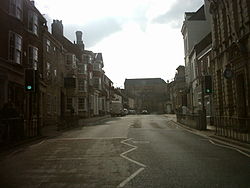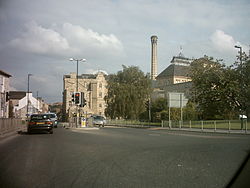Tadcaster
| Tadcaster | |
| Yorkshire West Riding | |
|---|---|
 Tadcaster from Bridge Street | |
| Location | |
| Grid reference: | SE4843 |
| Location: | 53°53’7"N, 1°15’43"W |
| Data | |
| Population: | 7,000 |
| Post town: | Tadcaster |
| Postcode: | LS24 |
| Dialling code: | 01937 |
| Local Government | |
| Council: | Selby |
| Parliamentary constituency: |
Selby and Ainsty |
Tadcaster is a modest market town in the West Riding of Yorkshire, standing by the route of the Great North Road some 15 miles east of Leeds and 10 miles west of the county town, York.
Tadcaster is the lowest town on the River Wharfe before it joins the River Ouse about 10 miles downstream. It lies partly within the Ainsty of York, but mostly in Barkston Ash wapentake.
History
Roman and Mediæval
Tadcaster was founded by the Romans, who named it Calcaria from the Latin word for lime, reflecting the importance of the area's limestone geology as a natural resource for quarrying, an industry which continues today and has contributed to many notable buildings including York Minster. Calcaria was an important staging post on the road to Eboracum (York), and grew up at the river crossing.
The nae of Tadcaster was given by the ancestral English, but taking its suffix caster, which in Old English signifies a city or a walled town, from the Latin word castra meaning 'fort'. Tadcaster is mentioned in the Anglo-Saxon Chronicle as the place where King Harold assembled his army and fleet before entry into York and subsequently on to the Battle of Stamford Bridge in 1066.
The town is mentioned in the 1086 Domesday Book as Tatecastre:
- Two Manors. In Tatecastre, Dunstan and Turchil had eight carucates of land for geld, where four ploughs may be. Now, William de Parci has three ploughs and 19 villanes and 11 bordars having four ploughs, and two mills of ten shillings (annual value). Sixteen acres of meadow are there. The whole manors, five quaranteens in length, and five in breadth. In King Edward's time they were worth forty shillings; now one hundred shillings.
In the 11th century William de Percy established Tadcaster Castle, a motte-and-bailey fortress, near the present town centre using stone reclaimed from Roman rubble. The castle was abandoned in the early 12th century, and though briefly re-fortified with cannon emplacements during the Civil War, all that remains is the castle motte. The outline of the long demolished southern bailey still impacts the geography of surrounding streets.
The original river crossing was probably a simple ford near the present site of St Mary's Church, soon followed by a wooden bridge. Around 1240, the first stone bridge was constructed close by, possibly from stone once again reclaimed from the castle.
Civil War
At 11am on Tuesday 7 December 1642 began the Battle of Tadcaster, an incident during the Civil War fought on and around Tadcaster Bridge between Sir Thomas Fairfax's Parliamentarian forces and Sir Thomas Glemham's Royalist army. The present day Wharfe bridge was constructed on the foundations of the stone original in around 1700, though it has been substantially modified at least twice since then. The bridge marks the boundary of the Ainsty of York within the West Riding.
Market
A market has been held at Tadcaster since 1270, when Henry de Percy obtained a royal charter from Henry III to hold 'a market and fair at his manor of Tadcaster', to be held each Tuesday. This ancient market place can be seen at the junction of Kirkgate and Bridge Street.
A stone base, believed to have been part of the original market cross, used to stand on Westgate, though this position is now held by the Tadcaster War Memorial. The present-day market is held on Thursdays on the carpark of Tadcaster Social Club on St.Josephs Street.
Industry



Tadcaster has long been associated with the brewing industry due to the quality and accessibility of the local water. Rich in lime sulphate after filtering through the Yorkshire limestone, in the right conditions freshwater springs - known locally as popple-wells - can still be seen bubbling up near St Mary's church. Tax registers from 1341 record the presence of two thriving breweries or brewhouses in the town, one paying 8d in tax and the other 4d. Today it is second in importance only to Burton-on-Trent as a British brewing centre.
Three breweries have survived into the present day, The Tower Brewery (Coors, formerly Bass), John Smith's and Samuel Smith's Old Brewery, which is also the oldest brewery in Yorkshire and the only remaining independent brewery in Tadcaster. A fourth stood by the river on the site of the present central carpark. Sam Smith's dray horses are a common sight on the streets of the town. Tadcaster is one of the very few Yorkshire towns which still has the industry it grew up around. This helps it to maintain a community spirit not often seen in other towns. Having three breweries in the town employing a large number of the locals the breweries have seen fit to subsidise several of the public houses in the town. These establishments offer the locally brewed drinks at approximately half the price you would expect to pay in a city.
Parish church

The parish church is St Mary the Virgin. A church was built here around 1150, though a wooden church may have preceded it. Destroyed by the Scots in 1318 in one of many incursions after the Battle of Bannockburn, St Mary's was rebuilt between about 1380 and 1480 but constant problems with flooding led to the structure's being taken down stone by stone and rebuilt between 1875 and 1877, the foundations raised by 5 feet; only the tower was left untouched. The money for this renovation - £8,426 4s 6½d - was raised by public subscription. In 1897 a new north aisle was added.
Sighst about Tadcaster
The Ark
The oldest building still in active use in Tadcaster is The Ark, built in the late 15th century, though it has been enlarged and altered many times since. Two carved heads on the front of the building are thought to represent the heads of Noah and his wife, hence the name.
Over its long life, the Ark has been a meeting place, a post office, an inn, a butcher's shop, a private house and a museum. It is currently the Town Council offices.
In the 17th century the Ark was known as Morley Hall, and was licensed for Presbyterian meetings. The Pilgrim Fathers met here and are reputed to have planned their voyage to America; an exact replica exists in Ohio.
The Viaduct

A quarter of a mile above the Wharfe bridge an imposing viaduct of eleven arches spans the River Wharfe. This was built as part of the projected Leeds to York railway promoted by the industrialist George Hudson through the York and North Midland Railway. The line was authorised in 1846, intended to run from Copmanthorpe to Cross Gates, joining the Church Fenton to Harrogate railway line between Tadcaster and Stutton.
The collapse of railway investment in 1849 led to the line's being abandoned after the viaduct had been built. The need for the line evaporated with the opening of the Micklethorpe to Church Fenton line in 1869. Between 1883 and 1959 the viaduct carried a siding that serviced a mill on the East side of the River Wharfe. The last time the viaduct was used to fetch and carry goods was in 1955. The structure is now a Grade-II listed building owned by Tadcaster Town Council for the use and pleasure of the local people.[1]
Conservation
Tadcaster Mere is to the south-east of the town centre, towards the village of Oxton. The Mere is the remnant central part of a former lake basin which extended over an area of about 750 acres, formed during the most recent or Devensian Ice Age (which ended 10,000 years ago, when present-day Tadcaster would have been situated at the southernmost limit of glaciation) by the long, low embankment of debris known as the Escrick Moraine, which is composed of debris left behind by the Vale of York Glacier.
The Mere is a site of current palaeontological interest, as it is currently believed to be the site of the earliest discovery of the plesiosaur (while unproven, the skeletal fragments found in Tadcaster at the least match the age of those found elsewhere).[2]
Scientific analysis of the mere, in particular sedimentary pollen studies, provides insight into the geological history and makeup of the local environment and allows accurate dating of events before, during and after the Devensian ice age.
Media
- Newspapers:
- The Press
- The Wetherby News
- The Yorkshire Post.
Sport
- Football:
- Tadcaster Albion AFC
- Tadcaster Magnets
- Running: Tadcaster Harriers
- Basketball: Tadcaster Tornadoes
The route of The White Rose Way, a long distance walk from Leeds to Scarborough passes through the town.
Outside links
| ("Wikimedia Commons" has material about Tadcaster) |
- Town Council and general Tadcaster site
- Tadcaster community website
- Historical site
- Local scooter club
- Tadcaster Leisure Centre
- Tadcaster Tornadoes Basketball Team
- Tadcaster Community Swimming Pool Trust
- Yorkshire Coastliner
- Office for National Statistics
- Vision of Britain through the ages: Tadcaster